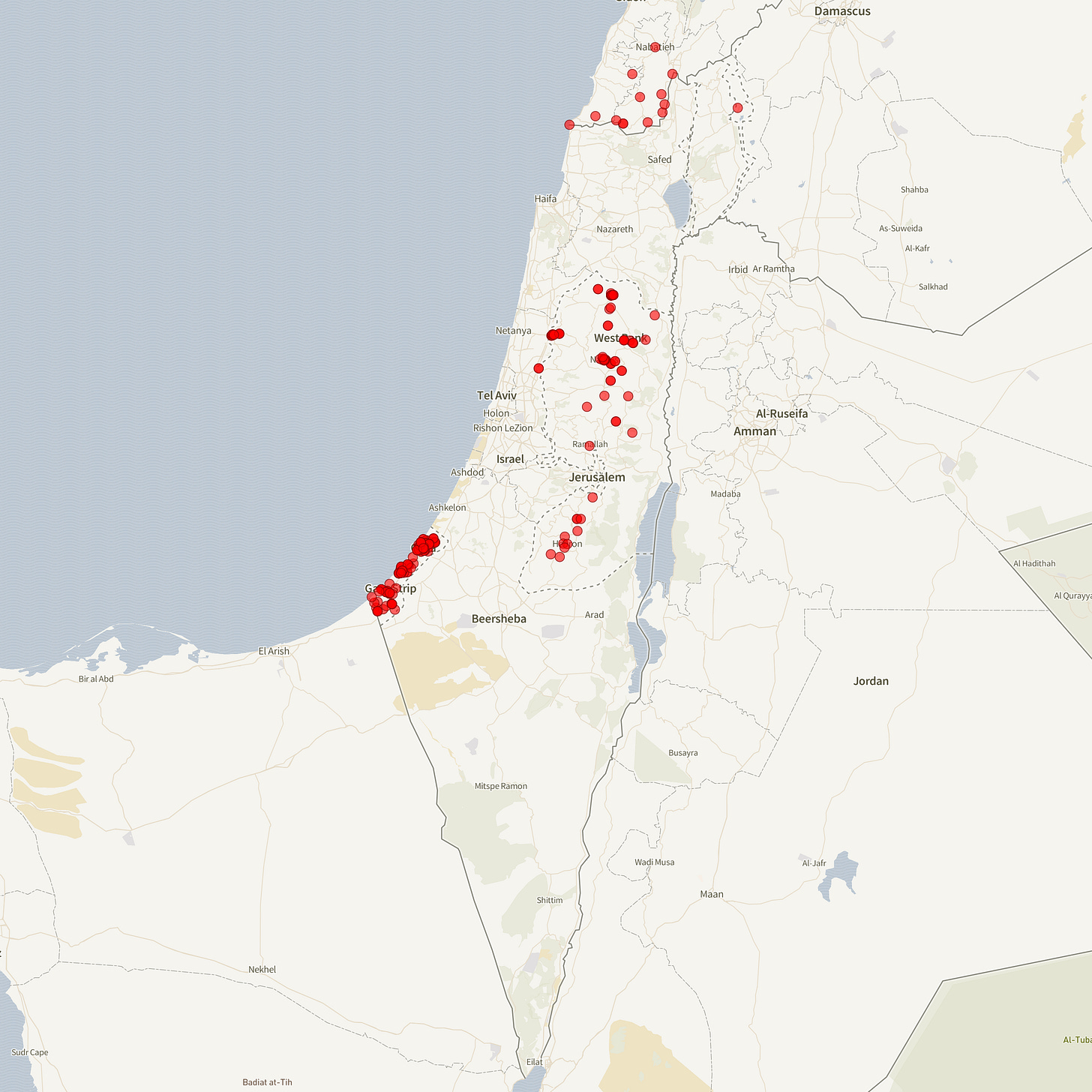No Sanctuary
Israel has turned hospitals, ambulances, and medics into military targets
Parsing Israel’s documented attacks on regional health infrastructure data reveals a systematic and sustained pattern of violence against physical infrastructure and personnel across the broader Middle East, with Palestine bearing the overwhelming burden of these attacks.
Based on Insecurity Insight’s year-to-date figures, the Israeli state has carried out 431 attacks across the area in the last 365 days, resulting in 659 healthcare workers killed, 73 facilities damaged, and 15 healthcare facilities destroyed across Palestine, Lebanon, Syria, Iran, and Yemen. Palestine accounts for nearly 90% of all incidents (386 of 431) and 96% of healthcare worker fatalities (633 of 659). The concentration of death in destruction across Palestine is centered in Gaza as a result of the zionist movement’s ongoing genocide.
The geographic spread of Israeli military operations against healthcare highlights the Western imperialist dimension of the Israeli state. The data captures Israeli attacks on health infrastructure and personnel in Lebanon (13), Iran (30), Syria (1), and Yemen (1). Each Israeli military operation has damaged or destroyed medical infrastructure and killed critical healthcare workers. The Iranian figures alone show 23 healthcare workers killed and 13 facilities damaged, reflecting the October 2024 western strikes on Iran. Israel’s role in the region is not just one of colonizing Palestine, but doing so in order to operate as a base for imperial interests, targeting threats to Western hegemony by any means.

On October 2, 2025, Israeli forces struck an international health organization’s team with an airstrike while the team was waiting to begin work in Gaza. All staff were clearly marked, yet two were killed, and four were injured. This suggests either deliberate targeting or reckless disregard for protected persons under international humanitarian law.
That same day, October 2, 2025, between Khan Yunis and Rafah, Israeli special forces infiltrated a makeshift medical facility and abducted a female healthcare worker by the name of Tasneem Al-Hams. According to the incident report, she was assaulted, gagged, and dragged into a vehicle while soldiers fired on those attempting to intervene. Her father, Dr. Marwan Shafiq Al-Hams, was similarly abducted in July of this year and has been held in an Israeli interrogation center.
The last 30 days present a troubling picture of continued attacks despite international condemnation. All 27 recent incidents carried out by Israeli forces occurred in Palestine, with six facilities damaged, five healthcare workers killed, eight injured, one kidnapped, and two assaulted — despite Israel and the US championing a supposed ceasefire in Gaza. The attacks reveal diverse methods of violence: aerial bombardment of medical facilities, drone strikes near hospitals, artillery shelling in hospital vicinities, and ground operations that directly target medical personnel. All of this is coordinated not only by the military wing of the settler movement, but also by its civilian sector.
Beyond airstrikes and drone attacks across Gaza, the data documents systematic obstruction of emergency medical services. On October 19th, Israeli forces raided the Nur Shams refugee camp in Tulkarm, northwestern West Bank, with live ammunition, killing a Palestinian man inside his home. Medical teams attempting to reach the wounded man were deliberately delayed by Israeli forces, and a healthcare worker was physically assaulted. Israeli forces detained four others, including one whom Israeli forces had shot.
An October 13th incident demonstrates that threats extend beyond state military operations. A Red Cross healthcare worker was attacked and injured by Israeli settlers who were throwing stones, preventing him from reaching an affected family and forcing his withdrawal in Husan village in the Bethlehem Governorate. This illustrates how settler violence functions as an extension of the broader zionist system, restricting Palestinian access to medical care.
On Saturday, November 9th, Israeli settlers launched coordinated attacks on Palestinians, international activists, journalists, and healthcare workers during olive harvesting activities in two locations south of Nablus.
In Burin village, settlers assaulted Palestinian farmers and foreign solidarity activists using rocks and sticks while they were picking olives. A 57-year-old Palestinian, Bashar Eid, sustained injuries requiring hospital transport, while Palestinian Red Crescent Society (PRCS) medics provided first aid to four international activists at the scene.
A separate attack occurred in the town of Beita, where settlers attacked journalists, paramedics, and international activists participating in an olive harvest event in the Jabal Qamas area. Eleven people received medical treatment at Rafidia Governmental Hospital for injuries, including fractures and bruises, inflicted with rocks and clubs.
Critically, healthcare workers themselves became targets. The PRCS reported that its ambulance crews transported their own paramedics to the hospital after Israeli colonizers severely assaulted them. Five journalists were also injured in the attack.
The cumulative picture is one of healthcare as a target rather than a protected sphere. Zionist attacks on the regional healthcare system represent a long-term pattern rather than isolated “wartime incidents”. The destruction of 15 facilities and damage to 73 more in 2025 alone degrade the region’s healthcare systems’ capacity to serve local populations, creating lasting harm that extends far beyond immediate casualties — which, of course, is the very point of such attacks.
International humanitarian law designates healthcare infrastructure and workers as protected, yet this data points to the systematic violation of those protections. The pattern — combining direct attacks on marked personnel, the abduction of medical workers, the obstruction of ambulance services, and settler violence — objectively demonstrates that the region’s healthcare infrastructure is being treated as a legitimate military target rather than a protected civilian sphere.


